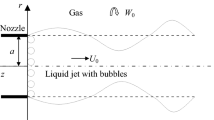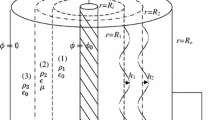Abstract
The breakup mechanism and instability of a power law liquid jet are investigated in this study. The power law model is used to account for the non-Newtonian behavior of the liquid fluid. A new theoretical model is established to explain the breakup of a power law liquid jet with axisymmetric and asymmetric disturbances, which moves in a swirling gas. The corresponding dispersion relation is derived by a linear approximation, and it is applicable for both shear-thinning and shear-thickening liquid jets. Analysis results are calculated based on the temporal mode. The analysis includes the effects of the generalized Reynolds number, the Weber number, the power law exponent, and the air swirl strength on the breakup of the jet. Results show that the shear-thickening liquid jet is more unstable than its Newtonian and shear-thinning counterparts when the effect of the air swirl is taken into account. The axisymmetric mode can be the dominant mode on the power law jet breakup when the air swirl strength is strong enough, while the non-axisymmetric mode is the domination on the instability of the power liquid jet with a high We and a low Re n . It is also found that the air swirl is a stabilizing factor on the breakup of the power law liquid jet. Furthermore, the instability characteristics are different for different power law exponents. The amplitude of the power law liquid jet surface on the temporal mode is also discussed under different air swirl strengths.








Similar content being viewed by others
Abbreviations
- a :
-
Nozzle radius, m
- n :
-
Power law index
- E :
-
Dimensionless rotational strength
- \( k_{r} \) :
-
Dimensionless wave numbers in the jet direction
- w r :
-
Dimensionless temporal disturbance growth rate
- w rmax :
-
Dimensionless maximum unstable growth rate
- Re n :
-
Generalized Reynolds number
- \( \bar{p}_{1} \) :
-
Jet pressure, Pa
- \( \bar{p}_{2} \) :
-
Gas pressure, Pa
- Q :
-
Gas–liquid density ratio
- u 0 :
-
Initial jet velocity, m/s
- A :
-
Gas rotational strength, m2/s
- We :
-
Weber number
- w i :
-
Dimensionless frequency of oscillation
- w imax :
-
Dimensionless dominant characteristic wave frequency
- K :
-
Consistency coefficient, Pa sn
- η 0 :
-
Initial disturbance amplitude
- ρ 1 :
-
Jet density, kg/m3
- ρ 2 :
-
Gas density, kg/m3
- σ :
-
Surface tension factor, N/m
References
Rayleigh L (1878) On the instability of jets. J Lond Math Soc 10:4–13
Chandrasekhar S (1961) Hydrodynamic and hydromagnetic stability. Oxford University Press, Oxford
Donnelly RG, Glaberson W (1966) Experiments on the capillary instability of a liquid jet. J Proc R Soc Lond 290:547–556
Weber C (1931) Disintergration of liquid jets. J Z Angrew Math Mech 11:136–159
Liu Z, Liu Z (2006) Linear analysis of three-dimensional Instability of non-Newtonian liquid jets. J Fluid Mech 559:451–459
Lü M, Ning Z, Yan K (2016) Comparative study on the spatial evolution of liquid jet under linear and nonlinear stability theories. J Acta Phys Sin 65(16). doi:10.7498/aps.65.166801
Avital E (1995) Asymmetric instability of a viscid capillary jet in an viscid media. J Phys Fluids 7:1162–1164
Yang HQ (1992) Asymmetric instability of a liquid jet. J Phys Fluids A 4:681–689
Lin SP, Lian ZW (1990) Mechanisms of the breakup of liquid jets. AIAA Journal 28:120–126
Lü M, Ning Z, Lu M et al (2013) On the spatial stability of a liquid jet in the presence of vapor cavities. J Phys Fluids 25(11). doi:10.1063/1.4830413
Yang L-J, Tong M-X, Hu Q-F (2013) Linear stability analysis of a three-dimensional viscoelastic liquid jet surrounded by a swirling air stream. J Non-Newton Fluid Mech 191:1–13
Breen G, Liu Z, Durst F (2000) Linear analysis of the temporal instability of axisymmetrical non-Newtonian liquid jets. Int J Multiph Flow 26:1621–1644
Liu Z, Liu Z (2008) Instability of a viscoelastic liquid jet with axisymmetric and asymmetric disturbances. Int J Multiph Flow 34:42–60
Gao Z (2009) Instability of non-Newtonian jets with a surface tension gradient. J Phys A Math Theor 42:65501
Andersson HI, Irgens F (1989) Film flow of power-law fluids. J Encycl Fluid Mech 9:617–648
Ng CO, Mei CC (1994) Roll waves on a shallow layer of mud modeled as a power-law fluid. J Fluid Mech 263:151–184
Cho YI, Hartnett JP (1982) Non-Newtonian fluids in circular pipe flow. J Adv Heat Transf 15:59–141
Hwang C, Chen J, Wang J (1994) Lin, Linear stability of power law liquid film flows down an inclined plane. J Phys D Appl Phys 27:2297–2301
Dandapat BS, Mukhopadhyay A (2001) Waves on a film of power-law fluid flowing down an inclined plane at moderate Reynolds number. J Fluid Dyn Res 29(3):199–220
Yang L-J, Du M-L, Hu Q-F (2012) Linear stability analysis of a power-law liquid jet. J Atom Sprays 22(2):141–231
Chang Q, Zhang M-Z, Bai Q-F (2013) Instability analysis of a power-law liquid jet. J Non-Newton Fluid Mech 198:10–17
Lü M, Ning Z, Yan K et al (2016) Temporal and spatial stability of liquid jet containing cavitation bubbles in coaxial swirling compressible flow. J Mecc 51(9):2121–2133
Versteeg HK, Malalasekera W (1995) An introduction to computational fluid and dynamics. British library cataloguing in publication data, London
Lin SP (2006) Two types of linear theories for atomizing liquids. J Atom Sprays 16(2):147–158
Gaster M (1962) A note on the relation between temporally-increasing and spatially-increasing disturbances in hydrodynamic stability. J Fluid Mech 14:222–224
Liao Y, Jeng SM, Jog MA (2000) The effect of air swirl profile on the instability of a viscous liquid jet. J Fluid Mech 424:1–20
Lin SP, Lian ZW (1990) Breakup of a liquid jet in a swirling gas. J Phys Fluids A 2:2134–2139
Potter MC, Wiggert DC (2009) Mechanics of fluids, 3rd edn. Cengage Learning, Stamford
Goedde EF, Yuen MC (1970) Experiments on liquid jet instability. J Fluid Mech 40(3):495–511
Kitamura Y, Takahashi T (1982) Breakup of jets in power law non-Newtonian liquid systems. Can J Chem Eng 60(6):732–737
Yi SJ et al (1996) The breakup and atomization of a viscous liquid. Acta Mech Sin 12:124–133
Bonnacucina Giulia, Martelli Sante, Palmieri GF (2004) Rheological, Mucodhesive and release properties of Carbopol gels in hydrophlic cosolvents. J Pharm 282:130
Acknowledgements
Project supported by the National Natural Science Foundation of China (Grant Nos. 51776016 and 51606006), Beijing Natural Science Foundation (Grant No. 3172025), the China Postdoctoral Science Foundation (Grant No. 2016M591061), and the Fundamental Research Funds for the Central Universities of Ministry of Education of China (Grant No. 2016JBM049).
Author information
Authors and Affiliations
Corresponding authors
Rights and permissions
About this article
Cite this article
Wang, XT., Ning, Z., Lü, M. et al. Temporal analysis of breakup for a power law liquid jet in a swirling gas. Meccanica 53, 2067–2078 (2018). https://doi.org/10.1007/s11012-017-0794-y
Received:
Accepted:
Published:
Issue Date:
DOI: https://doi.org/10.1007/s11012-017-0794-y




